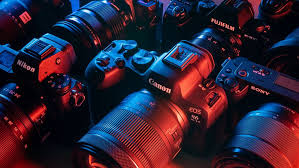The Evolution of Cameras: From Film to Digital
Cameras have come a long way since their inception, evolving from bulky film-based devices to sleek and powerful digital marvels. The history of cameras is a testament to human ingenuity and our constant quest for innovation.
The Early Days: Film Cameras
In the early days of photography, cameras relied on film to capture images. These cameras used light-sensitive film that had to be developed in a darkroom to reveal the pictures. While film cameras were revolutionary in their time, they were limited by the number of exposures per roll and the need for physical storage of film reels.
The Digital Revolution
The advent of digital cameras marked a significant turning point in photography. Digital cameras replaced film with electronic sensors that captured images digitally. This allowed photographers to instantly view and store their photos on memory cards, eliminating the need for film development.
Modern Innovations
Today, digital cameras have evolved into sophisticated devices with advanced features such as high-resolution sensors, image stabilisation, and wireless connectivity. Mirrorless cameras have also gained popularity for their compact size and impressive image quality.
The Future of Cameras
As technology continues to advance, the future of cameras looks promising. Innovations such as artificial intelligence-driven features, 360-degree imaging, and improved low-light performance are shaping the next generation of cameras.
Conclusion
Cameras have undergone a remarkable transformation over the years, from humble beginnings as film-based devices to cutting-edge digital tools. Whether you are a professional photographer or an amateur enthusiast, the evolution of cameras offers endless possibilities for creativity and expression.
Top 6 Tips for Enhancing Your Photography Skills
- Use natural light whenever possible for better quality photos.
- Experiment with different angles and perspectives to make your photos more interesting.
- Learn about the rule of thirds to improve the composition of your shots.
- Adjust the aperture settings to control depth of field and focus on specific subjects.
- Keep your camera lens clean to avoid blurry or smudged images.
- Practice regularly to improve your photography skills and develop your own style.
Use natural light whenever possible for better quality photos.
When capturing photos with your camera, it is advisable to utilise natural light whenever feasible to enhance the quality of your images. Natural light can provide a soft and flattering illumination that brings out the details and colours of your subject in a more natural and appealing way. By utilising natural light effectively, you can achieve better clarity, contrast, and overall image quality in your photographs.
Experiment with different angles and perspectives to make your photos more interesting.
To enhance the visual appeal of your photographs, try experimenting with various angles and perspectives. By exploring different vantage points, such as shooting from a low angle or capturing a bird’s-eye view, you can add depth and intrigue to your images. Changing perspectives not only makes your photos more visually engaging but also allows you to convey unique stories and emotions through your lens. Embrace creativity and curiosity in your photography journey to discover new ways of seeing the world through your camera.
Learn about the rule of thirds to improve the composition of your shots.
Learning about the rule of thirds is a valuable tip for improving the composition of your shots with cameras. This fundamental principle divides the frame into a grid of nine equal sections, with key elements placed along the gridlines or at their intersections. By following this guideline, photographers can create more visually appealing and balanced images that draw the viewer’s attention to the subject in a natural and engaging way. Mastering the rule of thirds can enhance the overall quality and impact of your photographs, making them more compelling and professional-looking.
Adjust the aperture settings to control depth of field and focus on specific subjects.
Adjusting the aperture settings on your camera is a valuable tip for enhancing your photography skills. By manipulating the aperture, you can control the depth of field in your images, allowing you to focus sharply on specific subjects while creating a beautifully blurred background. This technique adds depth and visual interest to your photos, drawing attention to your intended focal point and creating stunning visual compositions. Experimenting with aperture settings opens up a world of creative possibilities and helps you capture more captivating and professional-looking photographs.
Keep your camera lens clean to avoid blurry or smudged images.
To ensure sharp and clear images, it is essential to keep your camera lens clean at all times. Dust, fingerprints, or smudges on the lens can greatly impact the quality of your photos, leading to blurry or distorted images. By regularly cleaning your camera lens with a soft microfibre cloth and gentle lens cleaning solution, you can maintain optimal image quality and capture stunning photographs with clarity and precision. Remember, a clean lens is key to achieving crisp and professional-looking shots.
Practice regularly to improve your photography skills and develop your own style.
To enhance your photography skills and cultivate a unique style, it is essential to practice regularly. By consistently capturing images, experimenting with different techniques, and honing your craft, you can improve your abilities behind the lens. Through practice, you will not only refine your technical skills but also discover your artistic vision and develop a distinctive photographic style that sets you apart as a photographer.



